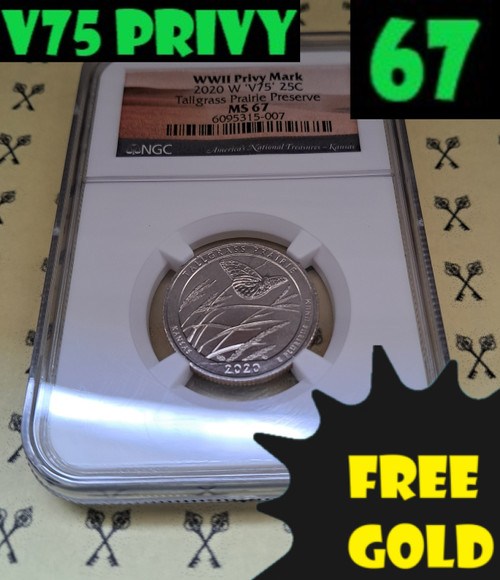-
RESTOCKING

2005-S Kansas Quarter NGC PF 69 Ultra Cameo with FREE GOLDBACK*
MSRP: $22.50$14.91 -
RESTOCKING

Kansas
Will Kansas be the next state to get a Half Goldback?

Kansas Half (1/2) Goldback Concept. Click the image for all 0.5 Goldbacks for sale.
Why Kansas Should Be the Next State to Get a Goldback Series
The Sunflower State’s Golden Potential
Kansas, the "Sunflower State," has a golden lure woven into its lore—from Francisco Coronado’s 1541 quest for Quivira’s fabled gold to whispers of buried treasure near the Little Arkansas River in the 1700s. While no major gold deposits were found, Kansas’s history of resilience—from surviving the Bleeding Kansas era to thriving as the nation’s breadbasket—makes it a natural fit for the Goldback, a voluntary, gold-based currency. In a state that’s fed the world, why not pioneer a new way to grow wealth with gold?
Legislative Momentum: Gold Transactions Unleashed
Kansas is charging toward a gold-friendly future. In 2019, the state repealed sales taxes on gold and silver via HB 2123, a big win for sound money. In 2024, House Bill 2729 and Senate Bill 513 proposed recognizing gold and silver specie as legal tender and establishing a state bullion depository—though stalled, they’ve set the stage. As of February 2025, Senate Bill 115 (SB 115), filed earlier this month, has passed the Senate Federal and State Affairs Committee, authorizing a depository and state gold reserves, awaiting full Senate action. These moves make Kansas a Goldback hotspot, ready for everyday gold use.
Economic Strength and Kansas Pride
The Goldback fuels Kansas’s economy and spirit. Starting at 1/1000th of an ounce, it’s perfect for small transactions—from Topeka’s food co-ops to Dodge City’s craft markets. With inflation looming, its gold backing offers stability, echoing Kansas’s steadfast nature. Imagine a Goldback series showcasing state icons: wheat fields, the State Capitol, or Coronado’s trail. These notes would be collectibles, boosting tourism and pride. Businesses adopting Goldbacks could draw sound-money fans, while dealers thrive under tax relief. This is Kansas’s chance to shine—literally.
Kansas-Specific Goldback Designs
Here’s how Kansas’s Goldback denominations could honor its significant people and places:
- 1 Goldback (1/1000 oz): Features Francisco Coronado searching for Quivira, honoring the 1541 expedition that tied Kansas to gold legends.
- 5 Goldback (1/200 oz): Depicts John Brown at Osawatomie, torch in hand, celebrating the abolitionist who shaped Bleeding Kansas.
- 10 Goldback (1/100 oz): Showcases the Kansas State Capitol dome in Topeka, its golden hue reflecting the state’s governance legacy.
- 25 Goldback (1/40 oz): Highlights Amelia Earhart soaring over Atchison, honoring the aviation pioneer born in Kansas.
- 50 Goldback (1/20 oz): Pictures a sunflower field near Wichita, capturing Kansas’s agricultural heart and natural beauty.
These designs turn the Goldback into a tribute to Kansas’s history and resilience, blending value with heritage.
A Golden Call to Lead the Heartland
Utah, Nevada, and others have Goldbacks, but Kansas can lead the Heartland. With SB 115 advancing, a top-10 Sound Money Index ranking, and a pioneering past, Kansas is primed to champion this currency in the Midwest. Let’s urge the Senate to pass SB 115 and launch a Kansas Goldback series. Imagine gold in every hand—from Lawrence to Liberal—proving the Sunflower State isn’t just America’s breadbasket but its golden frontier. The time is now.
Rise up. Make Kansas golden.
History of Gold in Kansas
Kansas, known for its vast prairies and agricultural heritage, has a lesser-known but intriguing history with gold. While not a major gold-producing state, Kansas played a strategic role in the broader context of American gold exploration, migration, and the economic shifts that gold discoveries brought to the nation.
Gold Rush Connections
During the mid-1800s, Kansas served as a critical thoroughfare for pioneers heading west during the California and Colorado Gold Rushes. The Santa Fe Trail and Oregon Trail, both of which passed through Kansas, were heavily traveled by those seeking fortunes in gold-rich territories. Towns such as Leavenworth and Fort Riley became important supply hubs for prospectors on their journey westward.
Gold Discoveries Within the State
While large-scale gold strikes never occurred in Kansas, small placer gold deposits were discovered in areas such as Smoky Hill River and Arkansas River. These deposits were minor and not economically viable for long-term mining, but they drew attention during periods of gold fever, especially in the late 1800s.
In fact, in the 1850s and 1860s, there were short-lived gold exploration efforts near the western border with Colorado, where the Colorado Gold Rush was in full swing. Kansas settlers occasionally joined these nearby ventures, and some even returned to Kansas with newfound wealth to invest in land and farming.
The Role of Forts and Frontier Commerce
Kansas was home to many frontier forts—such as Fort Larned and Fort Leavenworth—which served as economic centers during westward expansion. Gold and silver coinage from miners passed through these military and trading posts, further tying Kansas to the story of America’s gold-driven migration and commerce.
Modern Interest and Preservation
Today, Kansas embraces its pioneer and mining-related history through museums, trails, and historical markers. While no active gold mining takes place in the state, enthusiasts still pan recreationally in rivers and creeks, hoping to find trace flakes of placer gold.
Gold’s legacy in Kansas lies not in its mines, but in its role as a vital crossroads—helping move people, supplies, and ambitions toward the heart of gold-rich America.
From trail town to treasure route, Kansas played its part in the golden dreams of the 19th century.
Kansas State Coins for Sale with FREE GOLD
Celebrate Kansas' statehood with a Perfect Proof 70 Deep Cameo quarter.